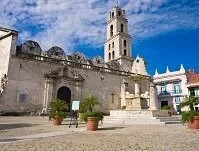Architecture of Cuba
WARNING: International disputes with Cuba are ongoing, please read this travel warning before going!

Old Havana
The early architecture of Cuba is severely limited as no true buildings exist from the pre-Columbian times. However once the Spanish arrived this rapidly changed as the island began a strong base in the Caribbean for the European colonists. Although the island's architecture as a whole is somewhat sporadic, the capital of Havana is one of Spanish America's best cities architecturally.
Among the earliest pieces of architecture is the Castillo de la Real Fuerza, one of the oldest forts in the Americas. This fort, built in the 1580s, sits on Havana's Malecon and is an incredible sight. Other forts in Havana include the San Salvador de la Punta (1580s) and the El Morro (1580s), which has an impressive lighthouse.
In their colonies, the Spanish generally built in the same styles that were popular in Spain at the time, especially when it came to their churches; this led to many Cuban colonial building to be built in the Baroque style, this is especially true in Havana. The Havana Cathedral (1748-1777) is one of the best examples of the Baroque style in Cuba, although numerous other large cities also have Baroque churches in their town centers. Many other impressive buildings from this time can be found in Old Havana and along Havana's Malecon.